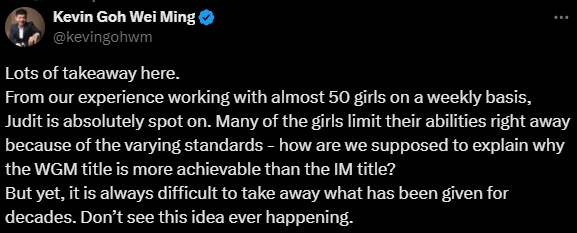
The FIDE title system
The FIDE title system is an odd system, and I would like to give a few thoughts on it, after listening to Judit Polgar repeating an argument a lot of people share, including some of my friends fighting for women’s place in chess – that women’s titles might not be helping.

I prefer to stay neutral on politics that don’t affect me. So, while the US election obviously will affect everyone, changes to women’s rights in the chess world are less likely to do so. In the legal system, they call this “standing”.
I have found big women’s prizes to be odd. I do not mind minor prizes for juniors, seniors, women’s, locals, rating prizes and friends of the arbiter. But when they are similar to the prize for winning the event, it signals that the players are players are playing different events from each other. I guess theoretically it could negatively affect me, but again, it never has. It is a discussion you have to be a few drinks in to take seriously, and I quite alcohol a decade ago.
Women’s titles is also an oddity. It is not quite clear how they are to be interpreted. Do they signal that women’s chess is inferior, and thus reaching a 2300 level, is equivalent to a man reaching 2500. There are about 400 WGMs, while more than 1800 GMs – from where about 50 are women. But female participation in international chess only includes 10%+ of chess players. Or are they there to create heroes for girls, so we can expand the female participation? Or are they just there, because they have always been there.
The differences between rating and titles
Listening to Judit talking about women’ titles possible abolishment, I am reminded of the main point of titles. They are not your rating. They reflect both three exceptional results, and a career high rating of at least 2500 (GM), 2400 (IM), 2300 (WGM), 2200 (WIM).
A few titles have different requirements, and are for this reason a bit “cheaper”. FM (2300), CM (2200) and WFM (2100) only requires that you reach the rating once, having played at least 30 games or so (I am fuzzy on the details, as the titles were never in my orbit). I never liked these titles much, as they did not include the norms (FM did for a short while).
The combination of exceptional results (norms – totalling at least 27 games) and a proof of a consistent high level (rating requirement), means that achieving the title actually is difficult. For many, it is the culmination of a year-long pursuit.
The problem with abolishing titles
And here we get to the problem with abolishing women’s titles, or introducing a super grandmaster title. People invested a lot of time and a lot of money in achieving the titles. It is possible that to some, them having the titles is not ideal. I say this with no hint of sarcasm, as I know Judit and others are genuine in their aspiration for improving chess. The overall effect may be positive to chess, to women’s chess or in some other way improve the system we have. But there is a strong responsibility to the people who invested time and money on playing chess, improving, and getting to a high level. Personally, I got offended, when Nigel Short and others over time, were proposing a SGM – Super GM title. The Grandmaster title has always been promoted as “the highest title in chess”. While reform to the title system has happened many times, making it easier (1990s) and harder (recently) to get the title, once given, it is for life. The title system would lose all credibility if titles were abolished, or their meaning was abolished, whether it is GM or WFM.
The idea that someone think I am as good as Nigel Short, in a situation where it matters, is zero. Or that a WGM and I are equally good at chess. However, FIDE has decided to promote female heroes in chess with the WGM title. As we are getting more and more new heroes, strong female players getting the GM title as a stepping stone, not as an exception, we may need it less and less. But to the people who got the title, it meant something. And we have to respect that.
Personally, I spent 20 years to achieve “the highest title in chess”, I would feel entirely betrayed by FIDE if they devalued or abolished it. I don’t think they will, and I especially cannot see why they would do so, when it would create intense disillusionment with the title system, while a the same time have rather unclear upsides.
There is one reform proposal I would make in restricting the value of the GM title – which could be applied to all other title norms. Don’t allow all the GMs in a norm to be below 2500. The average rating of them should be 2450, and one of them above 2500.
Historical context
ChatGPT, my preference for organising google searches – although not always entirely reliable – gives the following historical overview over FIDE titles (luckily ignoring the Arena title nonsense).
Grandmaster (GM): This is the highest title awarded by FIDE, and it was introduced in 1950. The title was first awarded to 27 players, including the legendary player Mikhail Botvinnik.
International Master (IM): Also introduced in 1950, the International Master title is a step below Grandmaster. It was awarded to strong players who had not yet achieved the highest level of mastery.
FIDE Master (FM): The FIDE Master title was introduced in 1978. It is a title for players who have demonstrated a high level of skill but are not yet at the IM level.
Candidate Master (CM): This is the lowest official title awarded by FIDE and was introduced in 2002. It recognizes players who have achieved a solid level of play, though not yet at the FM level.
Woman Grandmaster (WGM): This title, introduced in 1976, is the highest title awarded to female players and is roughly equivalent to the International Master title.
Woman International Master (WIM): Also introduced in 1950, this title is the female equivalent of the International Master title.
Woman FIDE Master (WFM): Like the FM title, this was introduced in 1978 but is specific to female players.
Woman Candidate Master (WCM): Introduced in 2002, this title is the female equivalent of the Candidate Master title.
